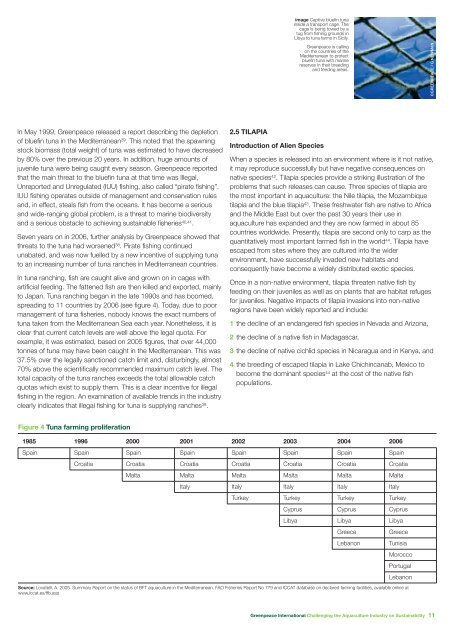Challenging the Aquaculture Industry on Sustainability-Greenpeace ...
Challenging the Aquaculture Industry on Sustainability-Greenpeace ...
Challenging the Aquaculture Industry on Sustainability-Greenpeace ...
Create successful ePaper yourself
Turn your PDF publications into a flip-book with our unique Google optimized e-Paper software.
image Captive bluefin tuna<br />
inside a transport cage. The<br />
cage is being towed by a<br />
tug from fishing grounds in<br />
Libya to tuna farms in Sicily.<br />
<strong>Greenpeace</strong> is calling<br />
<strong>on</strong> <str<strong>on</strong>g>the</str<strong>on</strong>g> countries of <str<strong>on</strong>g>the</str<strong>on</strong>g><br />
Mediterranean to protect<br />
bluefin tuna with marine<br />
reserves in <str<strong>on</strong>g>the</str<strong>on</strong>g>ir breeding<br />
and feeding areas.<br />
©GREENPEACE / G NEWMAN<br />
In May 1999, <strong>Greenpeace</strong> released a report describing <str<strong>on</strong>g>the</str<strong>on</strong>g> depleti<strong>on</strong><br />
of bluefin tuna in <str<strong>on</strong>g>the</str<strong>on</strong>g> Mediterranean 39 . This noted that <str<strong>on</strong>g>the</str<strong>on</strong>g> spawning<br />
stock biomass (total weight) of tuna was estimated to have decreased<br />
by 80% over <str<strong>on</strong>g>the</str<strong>on</strong>g> previous 20 years. In additi<strong>on</strong>, huge amounts of<br />
juvenile tuna were being caught every seas<strong>on</strong>. <strong>Greenpeace</strong> reported<br />
that <str<strong>on</strong>g>the</str<strong>on</strong>g> main threat to <str<strong>on</strong>g>the</str<strong>on</strong>g> bluefin tuna at that time was Illegal,<br />
Unreported and Unregulated (IUU) fishing, also called “pirate fishing”.<br />
IUU fishing operates outside of management and c<strong>on</strong>servati<strong>on</strong> rules<br />
and, in effect, steals fish from <str<strong>on</strong>g>the</str<strong>on</strong>g> oceans. It has become a serious<br />
and wide-ranging global problem, is a threat to marine biodiversity<br />
and a serious obstacle to achieving sustainable fisheries 40,41 .<br />
Seven years <strong>on</strong> in 2006, fur<str<strong>on</strong>g>the</str<strong>on</strong>g>r analysis by <strong>Greenpeace</strong> showed that<br />
threats to <str<strong>on</strong>g>the</str<strong>on</strong>g> tuna had worsened 38 . Pirate fishing c<strong>on</strong>tinued<br />
unabated, and was now fuelled by a new incentive of supplying tuna<br />
to an increasing number of tuna ranches in Mediterranean countries.<br />
In tuna ranching, fish are caught alive and grown <strong>on</strong> in cages with<br />
artificial feeding. The fattened fish are <str<strong>on</strong>g>the</str<strong>on</strong>g>n killed and exported, mainly<br />
to Japan. Tuna ranching began in <str<strong>on</strong>g>the</str<strong>on</strong>g> late 1990s and has boomed,<br />
spreading to 11 countries by 2006 (see figure 4). Today, due to poor<br />
management of tuna fisheries, nobody knows <str<strong>on</strong>g>the</str<strong>on</strong>g> exact numbers of<br />
tuna taken from <str<strong>on</strong>g>the</str<strong>on</strong>g> Mediterranean Sea each year. N<strong>on</strong>e<str<strong>on</strong>g>the</str<strong>on</strong>g>less, it is<br />
clear that current catch levels are well above <str<strong>on</strong>g>the</str<strong>on</strong>g> legal quota. For<br />
example, it was estimated, based <strong>on</strong> 2005 figures, that over 44,000<br />
t<strong>on</strong>nes of tuna may have been caught in <str<strong>on</strong>g>the</str<strong>on</strong>g> Mediterranean. This was<br />
37.5% over <str<strong>on</strong>g>the</str<strong>on</strong>g> legally sancti<strong>on</strong>ed catch limit and, disturbingly, almost<br />
70% above <str<strong>on</strong>g>the</str<strong>on</strong>g> scientifically recommended maximum catch level. The<br />
total capacity of <str<strong>on</strong>g>the</str<strong>on</strong>g> tuna ranches exceeds <str<strong>on</strong>g>the</str<strong>on</strong>g> total allowable catch<br />
quotas which exist to supply <str<strong>on</strong>g>the</str<strong>on</strong>g>m. This is a clear incentive for illegal<br />
fishing in <str<strong>on</strong>g>the</str<strong>on</strong>g> regi<strong>on</strong>. An examinati<strong>on</strong> of available trends in <str<strong>on</strong>g>the</str<strong>on</strong>g> industry<br />
clearly indicates that illegal fishing for tuna is supplying ranches 38 .<br />
2.5 TILAPIA<br />
Introducti<strong>on</strong> of Alien Species<br />
When a species is released into an envir<strong>on</strong>ment where is it not native,<br />
it may reproduce successfully but have negative c<strong>on</strong>sequences <strong>on</strong><br />
native species 42 . Tilapia species provide a striking illustrati<strong>on</strong> of <str<strong>on</strong>g>the</str<strong>on</strong>g><br />
problems that such releases can cause. Three species of tilapia are<br />
<str<strong>on</strong>g>the</str<strong>on</strong>g> most important in aquaculture: <str<strong>on</strong>g>the</str<strong>on</strong>g> Nile tilapia, <str<strong>on</strong>g>the</str<strong>on</strong>g> Mozambique<br />
tilapia and <str<strong>on</strong>g>the</str<strong>on</strong>g> blue tilapia 43 . These freshwater fish are native to Africa<br />
and <str<strong>on</strong>g>the</str<strong>on</strong>g> Middle East but over <str<strong>on</strong>g>the</str<strong>on</strong>g> past 30 years <str<strong>on</strong>g>the</str<strong>on</strong>g>ir use in<br />
aquaculture has expanded and <str<strong>on</strong>g>the</str<strong>on</strong>g>y are now farmed in about 85<br />
countries worldwide. Presently, tilapia are sec<strong>on</strong>d <strong>on</strong>ly to carp as <str<strong>on</strong>g>the</str<strong>on</strong>g><br />
quantitatively most important farmed fish in <str<strong>on</strong>g>the</str<strong>on</strong>g> world 44 . Tilapia have<br />
escaped from sites where <str<strong>on</strong>g>the</str<strong>on</strong>g>y are cultured into <str<strong>on</strong>g>the</str<strong>on</strong>g> wider<br />
envir<strong>on</strong>ment, have successfully invaded new habitats and<br />
c<strong>on</strong>sequently have become a widely distributed exotic species.<br />
Once in a n<strong>on</strong>-native envir<strong>on</strong>ment, tilapia threaten native fish by<br />
feeding <strong>on</strong> <str<strong>on</strong>g>the</str<strong>on</strong>g>ir juveniles as well as <strong>on</strong> plants that are habitat refuges<br />
for juveniles. Negative impacts of tilapia invasi<strong>on</strong>s into n<strong>on</strong>-native<br />
regi<strong>on</strong>s have been widely reported and include:<br />
1 <str<strong>on</strong>g>the</str<strong>on</strong>g> decline of an endangered fish species in Nevada and Ariz<strong>on</strong>a,<br />
2 <str<strong>on</strong>g>the</str<strong>on</strong>g> decline of a native fish in Madagascar,<br />
3 <str<strong>on</strong>g>the</str<strong>on</strong>g> decline of native cichlid species in Nicaragua and in Kenya, and<br />
4 <str<strong>on</strong>g>the</str<strong>on</strong>g> breeding of escaped tilapia in Lake Chichincanab, Mexico to<br />
become <str<strong>on</strong>g>the</str<strong>on</strong>g> dominant species 44 at <str<strong>on</strong>g>the</str<strong>on</strong>g> cost of <str<strong>on</strong>g>the</str<strong>on</strong>g> native fish<br />
populati<strong>on</strong>s.<br />
Figure 4 Tuna farming proliferati<strong>on</strong><br />
1985 1996 2000 2001 2002 2003 2004 2006<br />
Spain Spain Spain Spain Spain Spain Spain Spain<br />
Croatia Croatia Croatia Croatia Croatia Croatia Croatia<br />
Malta Malta Malta Malta Malta Malta<br />
Italy Italy Italy Italy Italy<br />
Turkey Turkey Turkey Turkey<br />
Cyprus Cyprus Cyprus<br />
Libya Libya Libya<br />
Source: Lovatelli, A. 2005. Summary Report <strong>on</strong> <str<strong>on</strong>g>the</str<strong>on</strong>g> status of BFT aquaculture in <str<strong>on</strong>g>the</str<strong>on</strong>g> Mediterranean. FAO Fisheries Report No 779 and ICCAT database <strong>on</strong> declared farming facilities, available <strong>on</strong>line at<br />
www.iccat.es/ffb.asp<br />
Greece<br />
Leban<strong>on</strong><br />
Greece<br />
Tunisia<br />
Morocco<br />
Portugal<br />
Leban<strong>on</strong><br />
<strong>Greenpeace</strong> Internati<strong>on</strong>al <str<strong>on</strong>g>Challenging</str<strong>on</strong>g> <str<strong>on</strong>g>the</str<strong>on</strong>g> <str<strong>on</strong>g>Aquaculture</str<strong>on</strong>g> <str<strong>on</strong>g>Industry</str<strong>on</strong>g> <strong>on</strong> <strong>Sustainability</strong> 11












